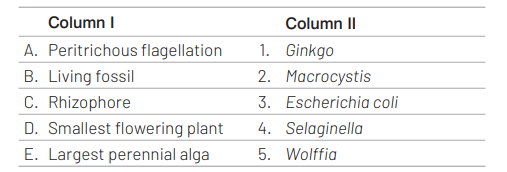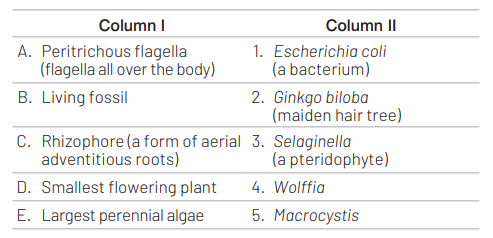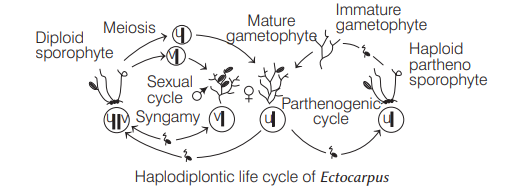Question
Match items in column I with those in column II

Select the correct answer from the following. [CBSE AIPMT 2005]
A B C D E A B C D E
(a) 3 1 4 5 2 (b) 2 1 3 4 5
(c) 5 3 2 5 1 (d) 1 2 5 3 2
Answer/Explanation
Ans. (a)

Question
Life cycle of Ectocarpus and Fucus respectively are [NEET 2017]
(a) Haplontic, Diplontic
(b) Diplontic, Haplodiplontic
(c) Haplodiplontic, Diplontic
(d) Haplodiplontic, Haplontic
Answer/Explanation
Ans. (c)
Ectocarpus and Fucus respectively show haplodiplontic and diplontic life cycle.

Concept Enhancer In Ectocarpus sporic meiosis occurs and haploid biflagellate meiozoospores are formed. They germinate to produce gametophytic thalli. The gametophytes liberate gametes, which fuse to form diploid zygote, which gives rise to a diploid plant.
Question
Metagenesis refers to [CBSE AIPMT 2015]
(a) the presence of different morphic forms
(b) alternation of generation between asexual and sexual phases of an organism
(c) occurrence of a drastic change in form during post-embryonic development
(d) the presence of a segmented body and parthenogenetic mode of reproduction
Answer/Explanation
Ans. (b)
Metagenesis in an organism refers to the reproduction characterised by the alteration of a sexual generation and a generation that reproduces asexually, i.e. alteration of generations.
Question
Which one of the following is considered important in the development of seed habit? [CBSE AIPMT 2009]
(a) Dependent sporophyte
(b) Heterospory
(c) Haplontic life cycle
(d) Free-living gametophyte
Answer/Explanation
Ans. (b)
Heterospory is the production of spores of two different sizes and of two different developmental patterns. It is the most important evolutionary development in the vascular plants because it has ultimately lead to seed development, which is seen in, Selaginella, Salvinia, Azolla, etc.
